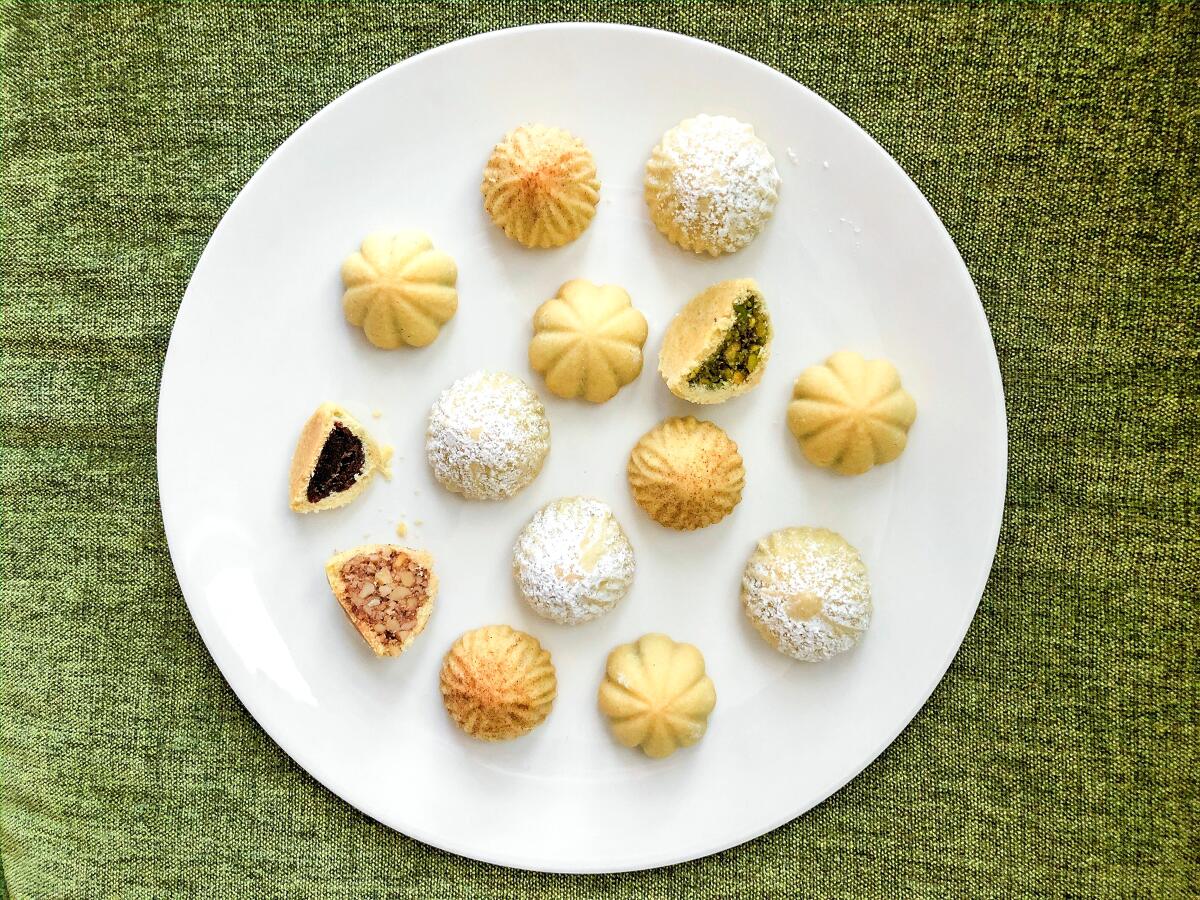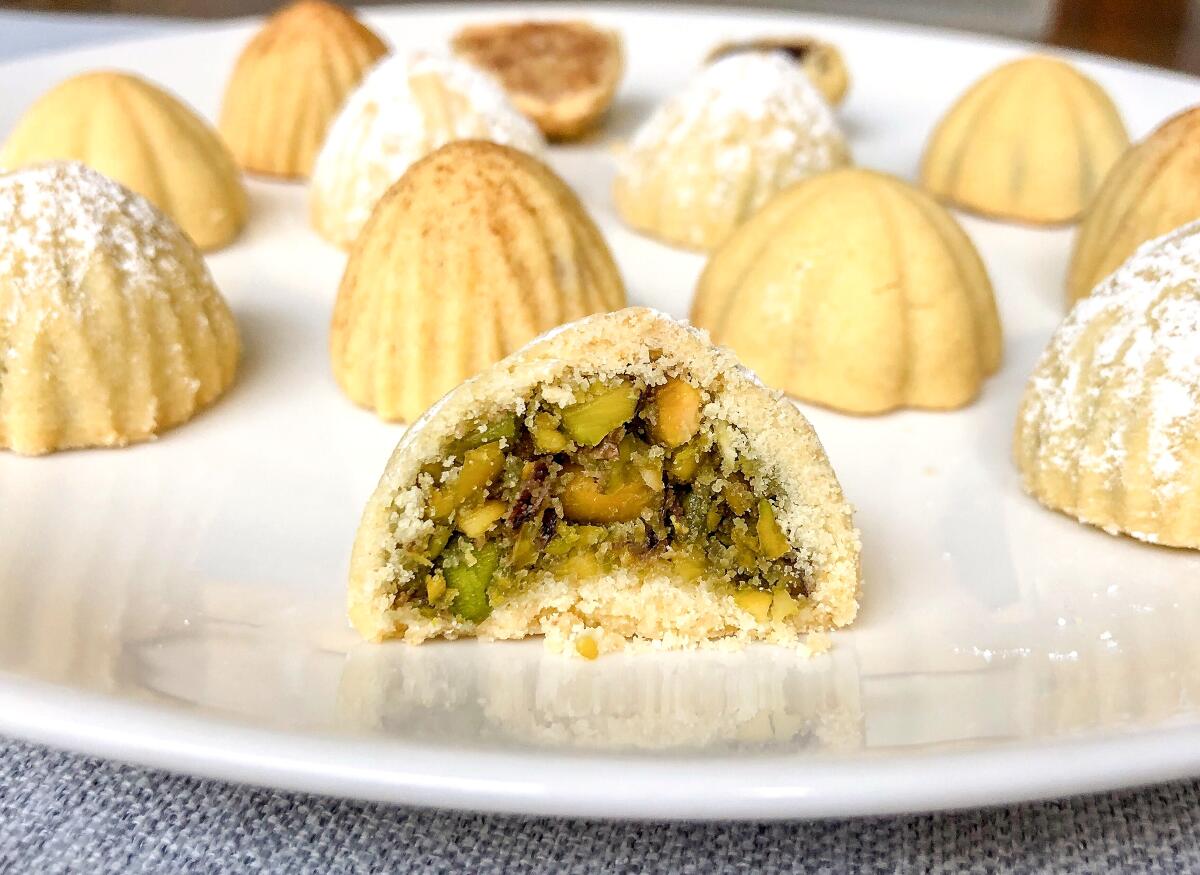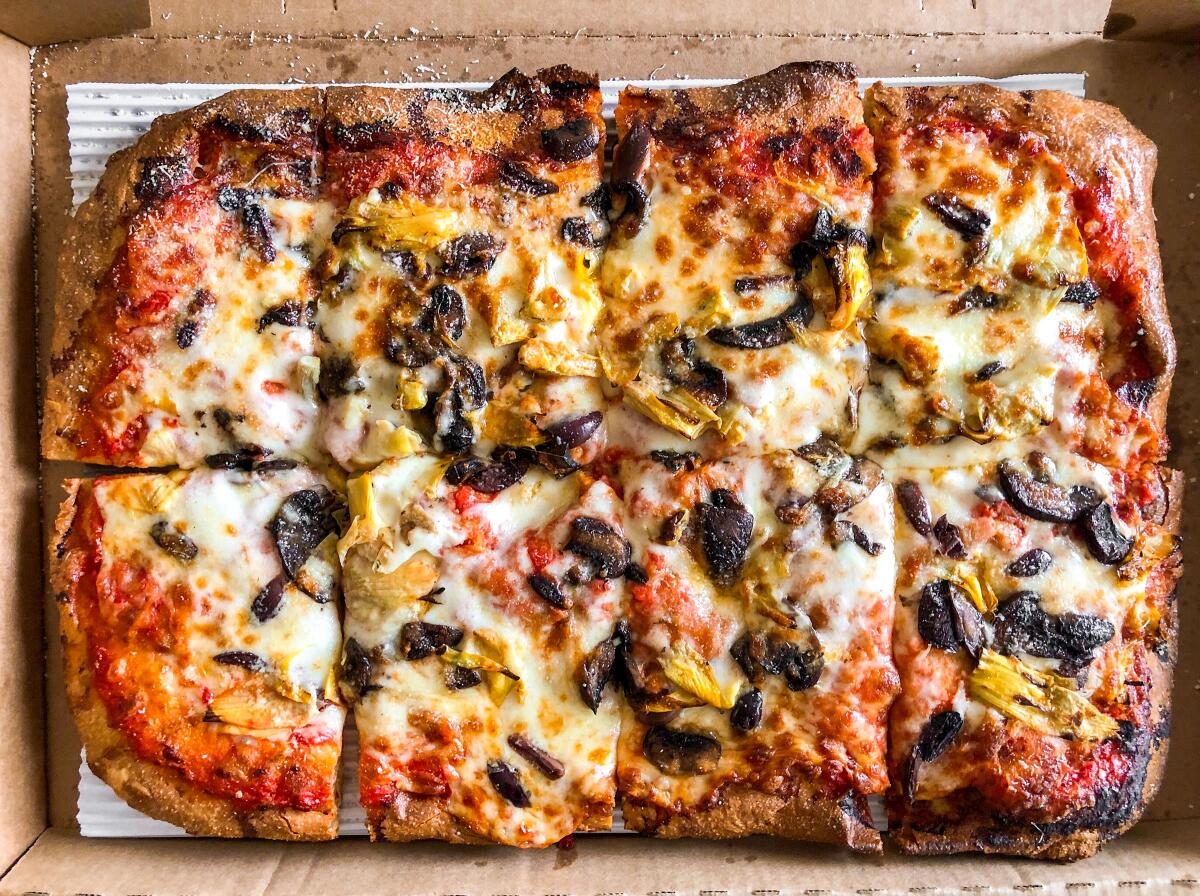My favorite cookie in Southern California

Around Easter, my social media feeds began marching out a steady parade of images featuring maamoul, the small filled pastries much loved in Lebanon, Syria and other swaths of the Levant. The algorithms know me too well.
Eat your way across L.A.
Get our weekly Tasting Notes newsletter for reviews, news and more.
You may occasionally receive promotional content from the Los Angeles Times.
A lightly yeasted dough is traditional for making maamoul, often a combination of flour and semolina perfumed with rose water or orange blossom water. Three spiced fillings predominate: date, pistachio or walnut. The most skilled bakers flatten the dough into a thin hull shaped around generous stuffing and then pressed into geometric patterns using a wooden mold called a tabe’. If it isn’t too reductive to call these creations “cookies,” then maamoul are my favorite cookie.
Though they’re a year-round treat, Levantine Christians particularly associate maamoul with Easter. Muslims often snack on them when breaking the fast during Ramadan, and they’re a vital part of an Eid al-Fitr celebration, which begins this year on May 23.
Shatila Bakery in Dearborn, Mich., is famous for its Middle Eastern pastries but especially its variations on baklawa. The bakery ships all over the country; my first taste of maamoul was from one of its holiday assortments a decade ago. After a recent Shatila maamoul gift box landed on my stoop and I scarfed them in isolation, I began seeking out superior locally made versions.
Maamoul are a staple in any Middle Eastern bakery, including savory flatbread specialists like the excellent Forn Al Hara in Anaheim and Furn Saj (with locations in Granada Hills and Glendora), both of which specialize in Lebanese manaeesh.
Enjoying this newsletter? Consider subscribing to the Los Angeles Times
Your support helps us deliver the news that matters most. Become a subscriber.
Poking around the Internet, I came across Suzy’s Sweets Boutique in Pasadena. Suzan Ohanian and her daughter Hermine Ohanian are Armenians who lived in Syria; they fled Aleppo when the civil war erupted in 2011, settling near family in the Los Angeles area. Six years ago they obtained a license to sell sweets from their home kitchen. The menu is extensive: macarons, cakes, baklava, lokum (a.k.a. Turkish delight) and Middle Eastern and French cookies of all kinds, including maamoul.

Friends, I’ve had no finer in the U.S. The exterior is tender-soft yet crumbly and taller than usual in stature; pointed or domed at the apex, they make room for a lavish proportion of filling. Hard to say which of the three versions bests the others: Cinnamon permeates the walnut, rose water offsets the pistachio without overdoing it, and the pureed date tastes pure and classic.
Maamoul come by the pound, or by the half-pound in combinations; the Ohanians accept orders through their website or by phone (I texted with them). They don’t offer delivery or shipping; pickup only. Plan 24 to 48 hours ahead for them to bake the maamoul fresh. Hermine mentioned she and her mother stay very busy during Ramadan.
Suzy’s Sweets Boutique also makes textbook, shattering-melting ghraybeh, a Lebanese sweet that falls somewhere between shortbread and sugar cookie and is traditionally garnished with a sliver of pistachio. But the maamoul — outstanding. If this ends up being your first taste of them, apologies. It might be hard to find better, though you can always consider making them yourself. A decade ago when my friend Anissa Helou began a blog, her very first was a recipe for maamoul filled with walnuts.
That said, I’m going to let Suzy’s do the maamoul baking.
Have a question for the critics?
Our stories
— Your must-read of the week: Patricia Escárcega interviews two undocumented restaurant workers struggling to survive during the COVID-19 crisis.
— Andrea Chang has major news from the world stage: Noma in Copenhagen will reopen May 21, serving cheeseburgers and wine.
— Los Angeles must follow examples set by San Francisco and New York by setting caps on the commissions that delivery apps can collect from restaurants until they are able to resume full dine-in service, says Lucas Kwan Peterson. (I couldn’t agree more.)
— Gustavo Arelleno profiles Albert Hernandez, owner of Alebrijes taco truck in Santa Ana. This line about ordering habits got me: “More [customers] seem to be ordering tortas, which he attributes to their size and the fact they can be stretched out longer as a meal unlike, say, tacos.”
—All the cooking content: Genevieve Ko brings the comforts of grilled cheese and tomato soup and a tutorial on carne asada; Ben Mims schools us on spatchcocking roast chicken (“Or as I prefer to call it, butterflying,” he says) and a foolproof salted caramel-chocolate tart. You signed up for their newsletter, yes?
— When will L.A. restaurant dining rooms reopen? Ugh, probably not for many more weeks. In the meantime, Amy Scattergood is maintaining the list of restaurants open for takeout and delivery, and she shares where to find your favorite springtime fruits and vegetables from area farmers. Garrett Snyder fills us in on restaurants and delivery businesses opening during the shutdown (a Goldburger double cheeseburger sounds mighty good).
— I have takeout ideas if you’re in the mood for Italian; do check out the philanthropic startup FEW For All, and try its Friday meal kit nicknamed the Table 60 Project.
— Finally, Jenn Harris has a story on the pleasures — and the red tape — around home cooks selling food to the public through an app called DishDivvy. I’ll be ordering gormeh sabzi from a cook in Glendale this weekend; maybe I’ll pick up some more maamoul while I’m in the area too.

Eat your way across L.A.
Get our weekly Tasting Notes newsletter for reviews, news and more.
You may occasionally receive promotional content from the Los Angeles Times.



